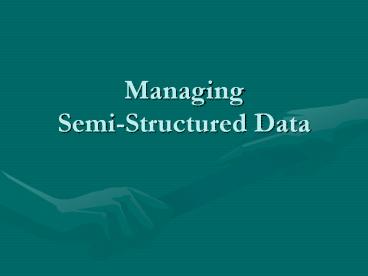Managing Semi-Structured Data - PowerPoint PPT Presentation
1 / 11
Title:
Managing Semi-Structured Data
Description:
Easy to create web information. Cannot all be stored in relational databases ... imposed by schemas, in terms of inflexibility and lack of evolution. ... – PowerPoint PPT presentation
Number of Views:11
Avg rating:3.0/5.0
Title: Managing Semi-Structured Data
1
ManagingSemi-Structured Data
2
Is the web a database?
3
RulesWhat Rules?
The web changed the digital information rules.
- Easy to create web information
- Cannot all be stored in relational databases
- Cannot be queried in traditional ways
4
Semi-structured Data
- Fully structured data
- Databases
- Hidden web
- Fully unstructured dataordinary text
- Semi-structured datathe grey area in between
- No good solutions no good software, tools, or
methodologies to manipulate semi-structured
data - Researchers dont even agree on the shape of
the problemmuch less, good approaches to solving
it.
5
Nature of the Problem
- Information embedded in text
- Keyword search insufficient to answer queries
- Natural language processing also insufficient
- Lack of agreement of vocabularies and schemas
- Reaching schema agreements among different
communities is one of the most expensive steps in
software design. - We need to be able to process information
without requiring a priori schema and
vocabulary agreements among participants.
6
Example eBay
- Impossible for developers to define an a
priori schema for the information. - Information stored in raw text and searched
using only keywords, significantly limiting its
usability. - Some standard entities (e.g., buyer, date, ask,
bid ), but the meat of the informationthe item
descriptionshas a rich and evolving structure
that isnt captured.
7
Why Schemas?
- Schemas assign meaning to the data and allow
automatic data search, comparison, and
processing. - Hierarchy of meaning
- Raw text strings (values)
- Data attribute-value pairs
- Information data in a conceptual framework
- Knowledge information with a degree of certainty
or community agreement - Meaning knowledge that is relevant or activates
- We have to learn to use and exploit schemas as
helpers, but not rely on their existence or allow
them to be constraining factors.
8
Schema-Agnostic Tools
Possible Places to Start
- Information retrieval (sophisticated search
engines?) - Find (maybe?) but not answer
- No DB-like query logic, updates, transactions
- XML
- XML data can exist w/wo schemas schemas can be
defined before or after - Mixed text/data content
- Languages for query (XQuery) and transformation
(XSLT) - OWL RDF
- RDF subject-predicate-object triples
- OWL ontological descriptions usually over RDF
triples - Classification inferencing
- Semantic annotation and tagging
9
Are We Stuck?
Whats Next?
- Better information-authoring tools (annotation
assistance) - Information extraction (automatic annotation)
- Creation and reuse of standard schemas and
vocabularies (ontology generation) - Mapping schemas to each other (schema mapping)
- Automatic data linking (data linking merging)
- Automatic processing of semi-structured data
(free-form queries)
Florescu (Embley)
10
Dataspace System
Whats beyond a database system?
- Supports data and applications in a wide variety
of formats all within a dataspace. - Offers an integrated means of searching,
querying, updating, and administering the
dataspace. - Has varying levels of service (e.g. best-effort
or approximate answers) - Includes tools to create tighter integration of
the data, as necessary.
Franklin, Halevy, Maier
11
We are still at day one.
We need to find a compromise to the tension
between the advantages of having schemas, in
terms of better understanding and automatically
processing the data, and disadvantages imposed by
schemas, in terms of inflexibility and lack of
evolution.
Florescu

